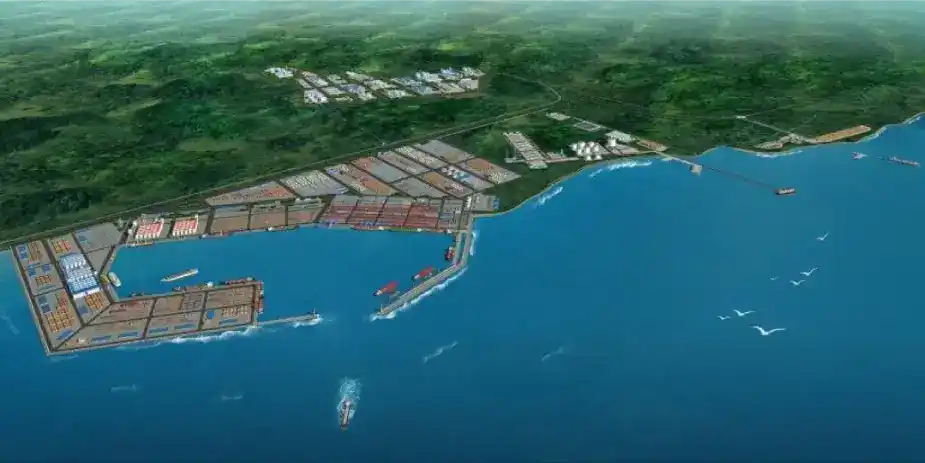Matarbari and Chittagong Port Establish Bangladesh as the Next Singapore.
Full-scale construction has resumed on the Matarbari Deep Sea Port after five long years.
Japan is leading the infrastructure development of Package One. Japanese companies TOA and Penta Ocean signed a deal with Chittagong Port to start the project.
At the same time, work is underway on the Bay Terminal in Patenga, Chattogram, with an investment of around 13,500 crore taka.
Dr. Yunus’s government launched this initiative to boost the capacity of Bangladesh’s seaports and support growing trade demands.
In today’s episode of Bangladesh 2.0, we’ll explore how these two mega projects could reshape the country’s economy and trade landscape.
We’ll also look at how Bangladesh is set to become a major force in the maritime economy of Southeast Asia.
The insights shared in this episode will help you make informed decisions about investing in Bangladesh or starting a business here.
Matarbari deep sea port project details
A few years ago, a 6.5 km long and 14.5-meter-deep artificial channel was constructed in Matarbari, Maheshkhali, at a cost of 9,000 crore BDT.
Since a coal-based power plant already operates in Matarbari, a coal jetty was also built earlier.
In 2023, a Japanese vessel, 230 meters in length with a 14-meter draft, arrived carrying 80,000 metric tons of coal.
This marked the largest ship in Bangladesh’s history to dock at any of its ports, signaling the start of Matarbari’s deep sea port potential.
However, the country’s political landscape, which had long been dominated by a corrupt, plundering regime controlled by Delhi, repeatedly delayed the port’s development.
After Dr. Yunus’s public uprising and the formation of a new government, the economy began to revive, and construction on the port resumed.
Japan will build a 460-meter container jetty within four years. It will also build a 300-meter multipurpose jetty as part of the terminal development.
The initial phase includes a terminal with both jetties. It will cost 6,200 crore BDT, fully funded by JICA (Japan International Cooperation Agency).
Strategic Importance of Matarbari Port
Oil tankers from the Middle East travel through the Malacca Strait to Japan, but China’s presence in the Bay of Bengal poses a threat to Japan’s energy security.
Matarbari Port will help Japan address this threat. Additionally, Japan views Bangladesh as a key development partner and sees the country as a future business hub.
Japan enabling it to play a stronger role in free trade in South Asia.
In the future, Matarbari Port is set to become a major hub for business in the Indo-Pacific region.
Matarbari Channel
Matarbari Port is protected by an artificial harbor, navigational channel, and sea wall. Both the harbor and maneuver basin have a water depth of 16 meters.
A new terminal will accommodate mother vessels, a capability no other port in the country can handle. It will feature a 460-meter-long quay on 20 hectares of land.
By 2029, the port will be ready to handle multi-purpose container vessels and manage up to 1.1 million containers. This capacity is expected to grow to 2.6 million containers by 2041.
Chittagong Port Bay Terminal
Chittagong Port is the lifeline of Bangladesh’s economy. It handles 75% of exports and 80% of imports, generating 60% of the national revenue.
The port started in 1860 with two jetties. Over time, more jetties and terminals were added. In 1926, the British government made it the region’s primary port. It remained vital even during the Pakistan era.
After independence, the Chittagong Port Authority took over in 1976.
In the last 50 years, Bangladesh’s economy grew fourfold, but the port’s infrastructure hasn’t expanded at the same rate.
Now, the Bay Terminal is under construction to increase the port’s capacity.
The terminal will stretch from the Chittagong EPZ in Patenga to Zohur Ahmed Stadium, covering nearly 6.5 kilometers.
Currently, containers are handled at three terminals, with the Patenga Terminal also starting container handling. Once the Bay Terminal is finished, the port’s capacity will more than double to 6 million TEUs.

What’s Inside the Chittagong Bay Terminal ?
In 2017, German company Shell Horn studied the technical, economic, and environmental feasibility of the Bay Terminal.
The report found that ships up to 300 meters long with a draft of 12 meters could dock at the terminal.
In 2024, the final design for the terminal was concluded, including four large terminals. Under a Public-Private Partnership (PPP) framework, two foreign companies will manage two of them.
One terminal will be operated by Dubai’s DP World. The terminals will be split into four parts: two for containers, one for oil and gas, and one for bulk goods.
Port of Singapore Authority (PSA) is investing $150 million in its terminal, while the oil and gas terminal will be built by the domestic East Coast Group, investing $350 million.
Currently, the country’s oil and gas storage capacity lasts 25 days. Once the oil and gas terminal is operational, capacity will increase to 60 days.
This project will bring the largest foreign investment in the country’s history, estimated at $800 million or around 90,000 crore Taka.
What Are the Benefits of the Bay Terminal?
Currently, containers can only be loaded and unloaded at the Chittagong Port during high tide, with a capacity to handle ships carrying 1,500 containers.
However, once the Bay Terminal becomes operational, it will be able to accommodate ships with up to 4,000 containers, and loading/unloading will be possible 24/7.
The terminal area is well-connected to the Dhaka-Chittagong highway, and it is very close to a railway station. Additionally, goods can be transported via waterways across the country directly from the Bay Terminal.
Conclusions
Bangladesh’s Ports Set to Lead Southeast Asia’s Maritime Industry. When talking about modern, well-organized ports, names like Singapore, Hong Kong, China, and Japan come to mind.
However, in the coming years, Chittagong Port in Bangladesh will join this list. With the addition of the Matarbari and Payra deep-sea ports in Maheshkhali, Bangladesh is poised to become a leader in port services in Southeast Asia.
Surrounding these ports and terminals, numerous economic zones will be developed, creating employment opportunities for millions of unemployed youth.



